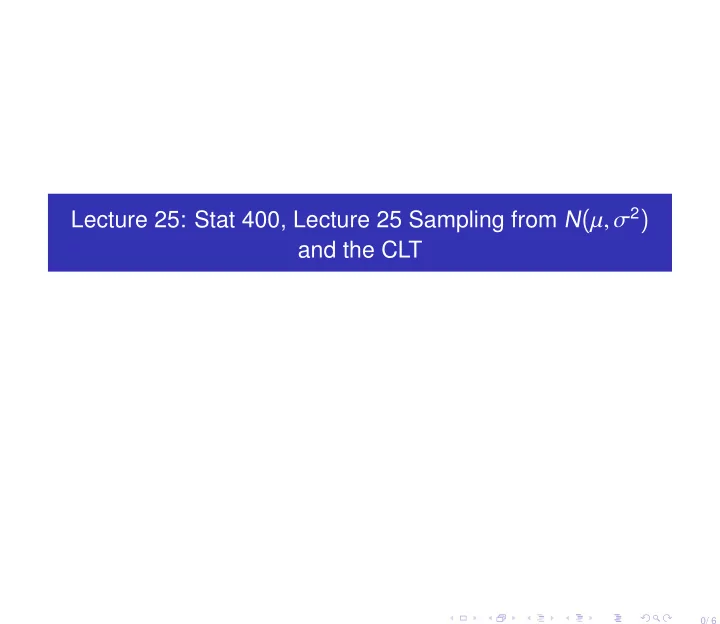

Lecture 25: Stat 400, Lecture 25 Sampling from N ( µ, σ 2 ) and the CLT 0/ 6
Suppose X 1 , X 2 , . . . , X n is a random sample from a normal population. We have seen that we should use the sample mean X to estimate the population mean µ and the sample variance S 2 to estimate the population variance σ 2 . 1/ 6 Lecture 25: Stat 400, Lecture 25 Sampling from N ( µ, σ 2 ) and the CLT
X and S 2 are random variables. $64,000 question How are X and S 2 distributed ? The answer is given by the following considerations Any linear combination of Independent normal random variables is again normal so X is normal. Since E ( X ) = µ and V ( X ) = σ 2 n we have µ, σ 2 � � X ∼ N n 2/ 6 Lecture 25: Stat 400, Lecture 25 Sampling from N ( µ, σ 2 ) and the CLT
Suppose Z , Z 2 , . . . , Z n are independent standard normal random variables. Then Z 2 1 + . . . + Z 2 b ∼ χ 2 ( n ) ( ∗ ) Chi-squared with n degrees of Z i = X i − µ Now ∼ N ( 0 , 1 ) σ So n � 2 n � X i − µ = 1 � � ( X i − µ ) 2 ∼ χ 2 ( n ) σ 2 σ i = 1 i = 1 Now replace µ by its estimation X Rule of thumb - every time you replace a quantity by its estimator you lose one degree of freedom in the chi-squared distribution 3/ 6 Lecture 25: Stat 400, Lecture 25 Sampling from N ( µ, σ 2 ) and the CLT
So by the “rule of thumb” n Y = 1 � ( X i − X ) 2 ∼ χ 2 ( n − 1 ) σ 2 i = 1 1 n Now S 2 = ( X i − X ) 2 � n − 1 i = 1 So Y = n − 1 σ 2 S 2 and we obtain the critical n − 1 σ 2 S 2 σχ 2 ( n − 1 ) ( ∗∗ ) Remark This isn’t a proof because we used “the rule of thumb” but the result is true 4/ 6 Lecture 25: Stat 400, Lecture 25 Sampling from N ( µ, σ 2 ) and the CLT
Bottom Line Theorem Let X 1 , X 2 , . . . , X n be a random Sample from a normal population with mean µ and variance σ 2 . Then µ, σ 2 � � (i) X ∼ N n (ii) n − 1 σ 2 S 2 ∼ χ 2 ( n − 1 ) (iii) X and S 2 are independent. The above statement is on exact statement but if we take a large sample ( n > 30 ) from any population with mean µ and variance σ 2 we may assume 5/ 6 Lecture 25: Stat 400, Lecture 25 Sampling from N ( µ, σ 2 ) and the CLT
Theorem (Cont.) to a good approximation that the population has N ( µ, σ 2 ) distribution and we have by CLT Theorem If X 1 , X 2 , . . . , X n is a large ( n > 30 ) random sample from any population with mean µ and variance σ 2 then (i) X ≈ N ( µ, σ 2 n ) (ii) S 2 ≈ χ 2 ( n − 1 ) (iii) X and S 2 are approximately independent. (then are not independent unless the population is normal.) 6/ 6 Lecture 25: Stat 400, Lecture 25 Sampling from N ( µ, σ 2 ) and the CLT
Recommend
More recommend